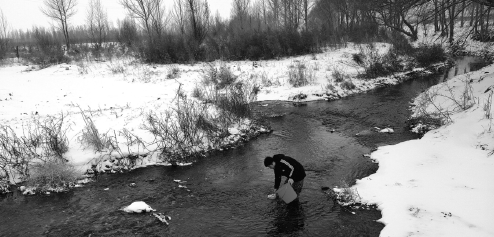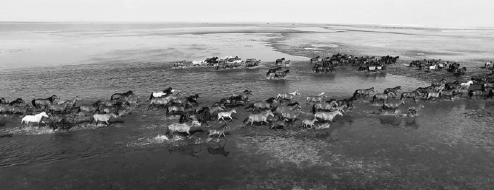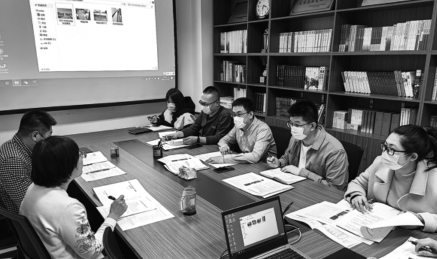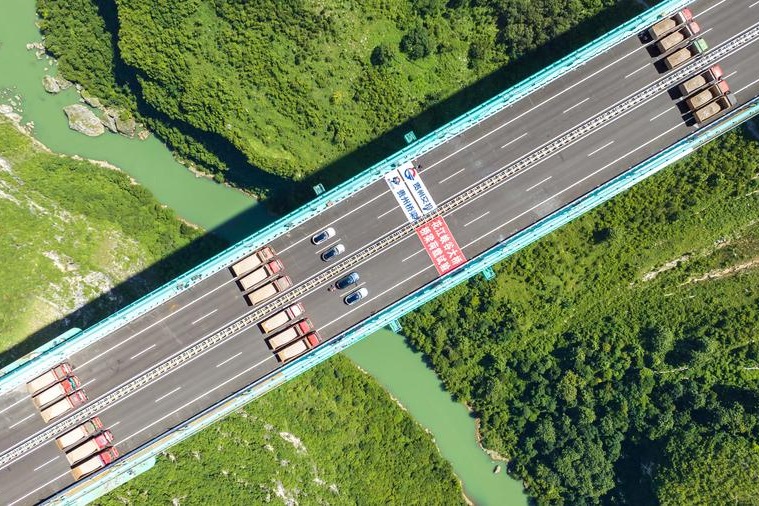Water guardian's tide of progress
Protecting lakes from pollution ensures environmentalist has a clear sense of achievement, report Yang Feiyue and Yuan Hui in Hohhot.

Hulun Lake resembles a snowfield as winter grips the country's northern area.
Yet, the pretty lake scene in Hulunbuir in the north of the Inner Mongolia autonomous region hides a multitude of hazards and difficulties for Xie Zhilei as he takes sample of its water in January.
"It's the biggest lake in North China, so we have to set up multiple checkpoints to get the big picture of its water conditions, from the banks all the way to the center," says the 35-year-old, director of a water environment monitoring division in Hohhot that is affiliated to the region's general environment monitoring station.
"Things are easier in the summer, when we can just take a boat," he says.
The lake usually freezes from November to April, so Xie and his colleagues would have to drive on the ice to reach the lake's deeper ends.
"The surface is rugged and sharp here and there, so it might slice open the tires," Xie says.
"You also have to be careful and circumvent the 'green ditch'," Xie adds as he keeps a fully opened eye on the ice surface.
Locals refer to precarious ice surface as the "green ditch".
"It's not thoroughly frozen, but is just a thin layer of ice, and you can clearly see the water underneath," Xie says.
"Once you drive on it, you'll run a big risk of dropping into the lake."
Years of work experience have enabled Xie to navigate potential dangers and get the water sampling done.
"The ditches are mostly formed because of the spring mouths at the bottom of the lake, as the temperature of spring water is relatively high," Xie explains.
But as their positions can be surveyed, the "green ditches" can thus be predicted after Xie and his team work with the lake's management committee.
"Another safe bet is to follow the existing skid marks," he says.
Despite the rich experiences of Xie and his team, precautionary measures have been taken in case of emergencies.
The team is divided in two cars that run at least 200 meters apart, so once an accident happens, rescue work from the other vehicle can be carried out immediately.
The water quality check has to be conducted once a month, come rain or shine.
"The freezing of the surface will result in a reduction of oxygen in the water, which could affect fish and other living creatures in the lake," Xie explains, adding that keeping track of the water quality will help preserve its ecology.
"We're more like a health checkup department. Once the problem is spotted, other related departments will come in to intervene."
After they reach a water sampling point, they will start drilling through the ice, which is sometimes 1.5 meters thick.
The manual work is demanding amid the wisps of white air rendered by the cold temperature that is 40 degrees below zero.
When the ice is drilled through, water sampling ensues according to stringent protocols.
"For example, it has to be about 50 centimeters below the water surface, for fear of interference from drifting leaves or ship oil residue," Xie explains.
The lake covers an area of more than 220,000 hectares and was one of the first lakes in the country to have water ecology evaluation carried out.
Xie spends the daytime with his colleagues sampling water and then analyzing data at night.
He knows about the perils of nature. He has traversed the uninhabited grasslands, stayed in the dormitories of border guards, experienced skin allergies brought about by mosquito bites, and even had a few close calls when the car was trapped in muddy swamps for a long time.
"The harsh natural environment comes with the territory," he says.
But Xie has come to enjoy it.
He loves to see the water distribution through the satellite images before planning the routes of his expedition.
"When I get back from a field trip, I review it online, and it will enhance my perception of the surrounding environment," Xie says.
Plus, he has got to appreciate nature's wonder as some of the water sites are tucked away in stunning landscapes.
Wearing thin-framed glasses, dark blue jeans and a thick sports jacket, Xie exudes a scholarly vibe.
He studied water engineering at the Hefei University of Technology in East China's Anhui province from 2006-10 out of his awareness of the importance of environmental protection.
"I watched the news a lot and I saw how the government put a premium on preserving nature, and talent in the field of water engineering was in demand," he recalls.
Xie went on to pursue his master's and doctoral degrees in lake ecology at the Inner Mongolia University in Hohhot.
"As you connect the dots of a water system, hydrology, climate and ecology, you'll find it very interesting, taken as a whole," Xie says.
Upon graduation, Xie received offers from economically developed cities, including Beijing, Shenzhen in Guangdong province and Nanjing in Jiangsu province, but he chose to stay put.
"I found three out of the four lakes, such as Hulun Lake and Daihai Lake in my hometown that I studied, were all highlighted by the government for strengthening ecological restoration," Xie says.
"It gave me a sense of mission, since I had already had a good grasp of related theories, which would pave the way for me to conduct field work," he says, adding that the decision was also partly out of nostalgia.
In order to ensure the surface water environmental quality monitoring data is factual, accurate and comprehensive, the central government and the autonomous region have built a number of monitoring stations.
A major responsibility of Xie's work is sorting out and analyzing mass data from those stations across the autonomous region.
"We need to make sense of those abstract data," Xie says.
For example, some data discrepancies might be temporary due to extreme weather like heavy rain or complex geological conditions, while some are actually a result of human activities.
When some of the water stations were put into use at the beginning, Xie and his team were able to identify certain enterprises that stealthily discharged pollutants through the data.
"It could lead to a significant increase in the main indicators of surface water through the analysis of continuous real-time data from the automatic monitoring," Xie says.
Then, Xie and his colleagues immediately reported the problem to law enforcement departments, which urged those enterprises to improve the sewage treatment process, and reduce the concentration of pollutant emissions.
But, since those stations can only be built on sites with access to electricity, water, good transportation and the internet, it's still necessary for Xie and his colleagues to conduct field research.
"The west of the region is relatively dry, so we wouldn't miss any rivers and lakes, but the eastern part enjoys relatively rich water resources, therefore, we choose our subjects selectively," he explains.
As his work experience grows, Xie has managed to deliver monthly environmental quality reports on key lakes in Inner Mongolia and takes a lead in drafting the construction plan for an ecological and environmental monitoring system for the Yellow River basin in the region.
"Although Zhilei is young, he has become a backbone (of the division) and takes on a large amount of important environmental monitoring work," says Tian Yongli, head of Inner Mongolia's general environmental monitoring station.
His work laid a solid technical foundation for pollution prevention and water improvement, Tian adds.
Xie's work has also enabled him to see the positive changes in local environment over the years.
"It surprised me to see that a long dried riverbed near my home (in Tongliao) started to have water flow through it in 2022," he says.
"And the water quality improvement has been evident over the past five years, with strange odors and colors in the water all gone."
In particular, the Hulun Lake has seen its water area expanded, wetland ecology recovered and biodiversity improved.
The water area of Hulun Lake has expanded to about 224,400 hectares, an increase of nearly 50,000 hectares from a decade ago, according to the Hulun Lake National Nature Reserve Administration.
The lake's water volume, meanwhile, has reached 13.97 billion cubic meters, a near-record high, the administration says.
The wetland ecology of the once dwindling lake has gradually recovered and the biodiversity in the area has continued to improve. Since 2016, the number of bird species recorded in the area has increased from 333 to 345, and the number of mammal species has risen from 35 to 38.
Xie has come to realize how the steady monitoring and accurate scientific analysis at work play a vital role in establishing environmental protection standards and helping to make major environmental protection decisions.
"I feel fortunate to be a guardian of the lucid waters and lush mountains," he says.



Today's Top News
- China steps up efforts to boost opening-up
- World's highest bridge passes stress test
- China scales up network to fuel growth of AI
- Ancient bronze casting art decoded
- Shenzhen SEZ to continue spearheading reform and opening-up
- War sacrifices never to be forgotten






























